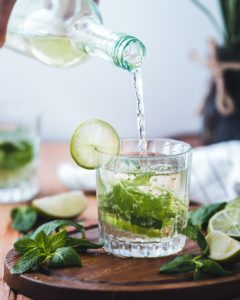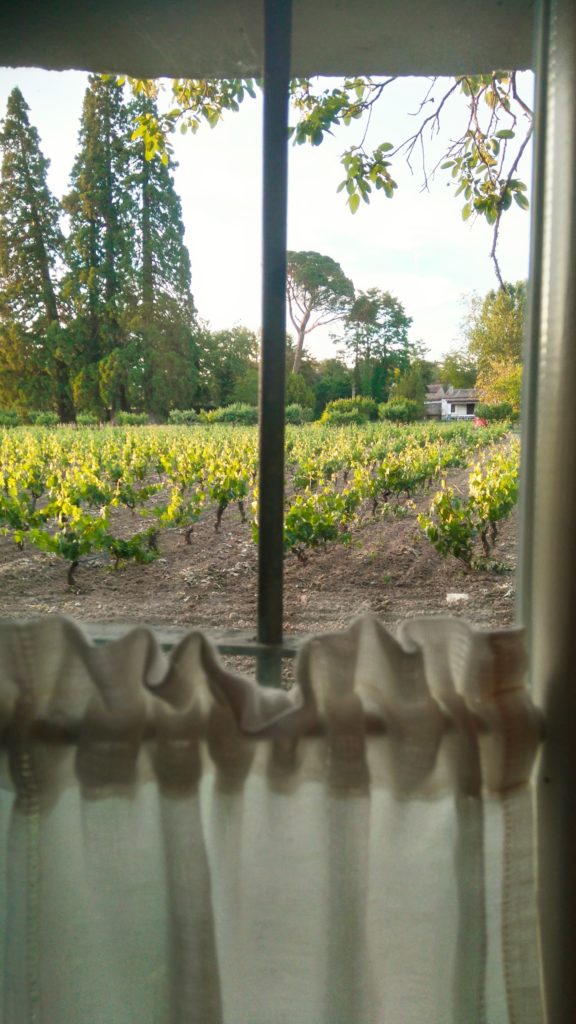
Summertime in a glass!
There’s nothing quite like a lovely cool vegan beverage on a hot sticky evening, is there? It could be a cheeky splash of rosé chilled to perfection, on a Friday night; a thirst-quenching ice-clinking sparkling soft drink with a juicy wedge of lime; or a cool elegant cocktail that transports you back to memories of that certain holiday, with the very first sip…
Or maybe you’re more of a winter-warmer type of person. Perhaps your tipple is a delicious eggless nog or a steaming mug of spiced cocoa with your favorite whipped vegan cream and chocolate shavings—or even a goblet of hot mulled wine, to warm the cockles of your heart on a biting autumnal night, with Jack-o’ Lanterns lining the streets, the smell of fallen leaves and frost still in the air…
The right beverage at the right time can be one of life’s lovely little pleasures. It has the power to invoke sensory connections with emotional memories, wishes, even dreams. And it can magically transport us to where and when we want to be, in an instant. It’s the mouthfeel, the taste, the texture, the temperature—done mindfully, sipping a beverage and fully experiencing the whole of that moment, can almost become a meditation—or even, dare I say it, a spell!
For those of us who are vegan, plant-based or transitioning to vegan, aside from using plant milk in our coffee, switching to agave from honey, and avoiding non-vegan flavored liqueurs, the veganness of beverages may well be something we feel is pretty safely covered.
Well, Dumplings, I hate to be the bearer of bad news, but it turns out that the drinks industry is pretty much like the rest of them. Often, their wares can involve hidden animal-based ingredients or processes, which aren’t easy to spot (and often aren’t even disclosed) on the packaging.
Some producers will add animal products into some drinks not labeled as being flavored with an animal product, other than in the ingredients list. One example is Worcestershire sauce, which traditionally contains anchovies. So sadly, that Bloody Mary is going to be non-vegan, unless it was made using vegan Worcestershire sauce (yep, that is a thing!).
There can also be things like animal-derived chemical additives, such as E140 (a red food coloring derived from crushed beetles) as well as minute quantities of things like honey, dairy, and even other animal-based flavorings like bacon (no, I’m not making that up—apparently some producers of stout use smoked bacon as one of the flavorings!!!), which can often be listed under the generic term “flavorings” or even “natural flavorings”!
And for us vegan folks, the biggest problem comes from the fact that many manufacturers still use things like isinglass (fish swim bladders), eggs, casein (from milk), and gelatin (from bones) to filter their beverages.

Which of these beers can I drink…?
Again, these do not have to be listed or mentioned on the packaging or labels. I don’t think I’ve ever seen them mentioned on a label, and they’re an awful lot more commonplace than you might have thought. Many transparent and translucent versions of soft drinks (flavored waters, etc) use animal-based products to keep the drink looking crystal clear. And there’s no hard and fast rule as to which brand is vegan-friendly and which isn’t. I was very surprised to discover a few years ago, that in the U.K., Pepsi Max is vegan-friendly, whilst Diet Pepsi is not! There’s no logical way to figure it out, unfortunately. So if you want to ensure your soft drinks are cruelty-free, it does require a bit of checking up.
The kinder alternatives
Vegan filtration methods and a how-to for handling sediment in your bottle
While the flavorings in some drinks are pretty apparent, and easy to steer clear of (like honey, dairy, and even eggs in Advocaat ) in terms of filtration, there are loads of great alternatives to using animals’ body parts and excretions. And the great news is that more producers are starting to switch to these—especially new companies that tend to be more open to the idea of transparency, health, and ethics as important, practical considerations.
Things like bentonite (a clay-based substance), seaweed, and activated charcoal can be used to filter beverages as direct replacements for the animal-based methods—and these have absolutely no detrimental effect to the end product, whatsoever! Hurray!!

And for many wines and beers, there’s often no fining product used at all, as the end product contains sediment. This is particularly the case with some bottled craft ales, where there’s a second fermentation process that happens in the bottle. For these, there will naturally be yeast sediment pieces, which you can leave in the bottle by storing it upright for a few hours before drinking it, and pouring off the ale carefully. But shaking up the bottle to create a cloudy ale where consuming the whole thing (yeast and all), is also considered by some beer fans to be the “proper” way of enjoying their ale.
As for wines, dealing with wine sediment doesn’t just apply to the unfiltered varieties. Vintage port, and red wines over 10 years old will also contain some sediment, due to age. There are varying ideas as to how to deal with this—there are some very particular ideas of how it “should” be done, some of which involve using a candle. But I like the more no-nonsense, practical approach suggested by The Wine Society. That’s to set the bottle in an upright position for at least 1 hour (and ideally 24 hours) before serving; and then to decant it slowly and carefully with gradual smooth movements. The aim of this, is to leave the sediment as undisturbed as possible (decanting into a plain water jug is fine – you don’t need a fancy crystal decanter), until the sediment reaches the “shoulders” of the bottle. If you’re new to this or want to make super sure you don’t end up with any sediment left in the wine, you can (according to the Wine Society) also use a filter or sieve (apparently a coffee filter, or even a clean stocking will do). I’d add that using a tea strainer can also work nicely (don’t forget to rinse it out immediately afterwards, to avoid oxidising the mesh – as once happened to one of mine which was used to strain cocktails, by my other half… but I digress).

But careful pouring/decanting and cloudy beverages are not the only options as far as non-filtered beverages are concerned. Many (high-end) Champagne houses have a proud tradition of using the “riddling” or “remuage” process (slowly revolving the bottle to a neck down position, gradually increasing the angle and letting gravity bring the sediment to the neck after all the fermentations have taken place. Then the sediment is finally ejected, to leave the champagne crystal clear and delicious). This process can be carried out on a special piece of equipment (taking around one week to complete), or by hand, by a cellar master (taking up to 6 weeks).
The challenge: transparency in the beverage industry
So with such a plethora of great-sounding alternatives out there, what’s the issue? Well Dumplings, here’s the rub. While the beverage industry is making great strides forward in terms of vegan labeling, and some new producers actually advertising their vegan credentials with pride, there’s a traditional attitude of antipathy towards the non-omnivore community (think “it’s only natural”/”it’s how we’ve always done it, and the product remaining exactly the same is the most important thing” and various other anti-progress clichés). Personally, it feels very much to me like these attitudes will change in time. But given the pride—veering into obsession— with preserving a certain idea of “tradition” that exists in the manufacture of beer and wine (particularly by firms who have been in existence for hundreds of years, often passed down in the same family), it’s taking more impetus and time for these attitudes to shift.
And to add to this heady brew, there’s also a widespread (bordering on pathological) dread of competitors stealing their methods, or using any knowledge of their production and what sort of a year they’re having, to gain an unfair advantage. The old “trade secrets” culture is very much alive and well, in some of the rural, tradition-steeped (veering into political activism in some areas) wine-making areas.
And others simply don’t feel the need or inclination to go to the trouble of giving out this information, since legally they are not required. And when it’s a firm which basically only makes the wine, and doesn’t bother with marketing/comms so much, well getting that information out there in a sector where vegan labeling is still very new and seems like a fad; well, there’s no impetus to do so….. yet.

Even with producers who answer queries about their beverages’ vegan-ness; there’s not yet a legal definition of the term “vegan,” and education around what “vegan” actually means is still an area that has a way to go. So unless the question posed specifically asks about ingredients and methods, and unless the answer received addresses both of these aspects clearly, or gives a negative answer, we’re left in the dark about whether the product is vegan or not.
Aren’t biodynamic wines and natural wines all vegan-friendly?
Sadly, this isn’t necessarily the case. While natural wines are low-intervention, and often unfiltered, they are sometimes partially filtered. So unless your bottle of natural wine is marked Vegan, or unless you’ve checked on Barnivore, or with the producer, there’s no guarantee that it’s vegan-friendly.
Biodynamic methods are a really fascinating topic in their own right. But in a nutshell, they see the ecosystem of the farm (or vineyard), as being an organism in its own right. They use herbalism, biorhythmic calendars, and traditionally integrate animals within their methods too. Biodynamic is the earliest of what later became termed “organic” agricultural methods, and it actually began way back in 1924.
And while a lot of biodynamic wines themselves can be made using vegan processing methods, the fact that the agriculturalists managing that vineyard may be keeping, managing, and using animals as part of the functioning and thriving of the ecosystem, is something that I’d draw the line at, and I’m sure I’m not alone in that.
But that’s not to say that this is the only way biodynamic can work. Within the framework of biodynamic agriculture, there is absolutely scope (and encouragement) for the farmers to develop their own individual relationship with the land/ecosystem, and develop their own practices and methods. And because it’s not prescriptive, although traditionally the method as implemented, did “own” and used animals, it could be that some biodynamic producers out there are using methods which are in line with the ethos of the vegan movement—perhaps the animals which are a part of and support their ecosystems are wild animals and insects, not “owned,” used or managed by the vineyard. My advice is (as with all wine and beverage producers) don’t take anything for granted, and do your homework!
Resources and what we can all do to help
Fear not, my friends! It may seem like a quagmire of epic proportions, but there is positive change happening right now. And as I mentioned earlier, this is a dynamic and evolving process of real, meaningful change, being driven by folks like you and me, at a grassroots level. This is something we can all contribute to, and it takes very little time and effort!
As with most forms of consumer-based culture change, precise, politely-posed questions and requests, en masse, are really effective approaches to help prompt change. With many larger and more modern companies, customer queries and responses are something that’s reported on at the highest level as a measure of success, and the more of us who step up and ask the tricky V questions, the more likely it is that higher management or even company directors will see our custom and the vegan movement as something they can’t ignore.
So it’s up to us to show why it’s in their interests to change, and why we’re a market they should want to woo! Why and how being ethical and transparent can support the best aspects of tradition, and where progress can be made, to support and enhance that traditional offer, rather than detract from it!

There’s already a gathering momentum behind the growth in popularity of plant-based lifestyles, which is being treated more and more seriously by many traditionally non-vegan firms, who are now stepping forward to be more inclusive.
And at the end of the day, once a few of the producers start to become more transparent, and even (dare I say it?) change their methods to being cruelty-free, we could well see a tipping-point, where all the others have to get on board, or miss out!
Beverage-based activism—how to do your bit!
One of the life-changing moments in my personal vegan transition process was discovering Barnivore—a godsend of a website which allows you to search various boozy drinks from around the globe, and lists whether or not they’re confirmed as vegan, non-vegan or unconfirmed.
This awesome tool is not only invaluable in purchasing decisions and nights out, but it relies on contributions from its users to keep growing, to keep verifying and keeping the data up to date.
And on Barnivore’s website, you’ll find a brilliant template letter to cut and paste into an email/snail mail, and ping it off to whichever companies/producers/vintners you desire. This letter sets out the question very plainly, including all the specifics of ingredients, production, bottling, and subsidiary companies’ practices. Whilst the responding company might avoid a yes/no, they will often give specific information about which of their products are suitable for Vegans, which definitely are not, and any specific practices or policies which are relevant to the questions. Any info (and even any sniffy remarks) uploaded is super helpful, because knowing what a companies’ attitude is to the question itself can be helpful and enlightening to know. Likewise, if attitudes within one company shift over time, over the course of several years of answering questions, that can be a lovely, encouraging thing to see!
Why go into all that technical detail? Why not just ask whether their products are suitable for vegans, and if they contain any animal products?
On the whole, spokespeople are often super positive, lovely people and want to give a “yes” to any possible customers, on the basis of their interpretation of the question. This is why being super specific is so important. If you ask a technical question, they’ll either need to decline to answer your question, or will need to approach the folks in operations, to get an answer. They may answer “yes” to your question if posed like this, if they believe that all the isinglass (fish swim bladders) has categorically been removed from the beverage before it goes on sale. But if you ask about processes as well as contents, you’ll be far more likely to get an accurate answer, as they’ll be responding to your actual question instead of the one they thought you were asking.
Change is happening, my friends—change which will benefit vegan consumers around the world, raise awareness, and (most importantly) benefit animals. Let’s all do our bit, and ask these companies for the information we all want, and share that knowledge as widely as possible!
Get more like this—Sign up for our daily inspirational newsletter for exclusive content!
__
Photo: Unsplash




